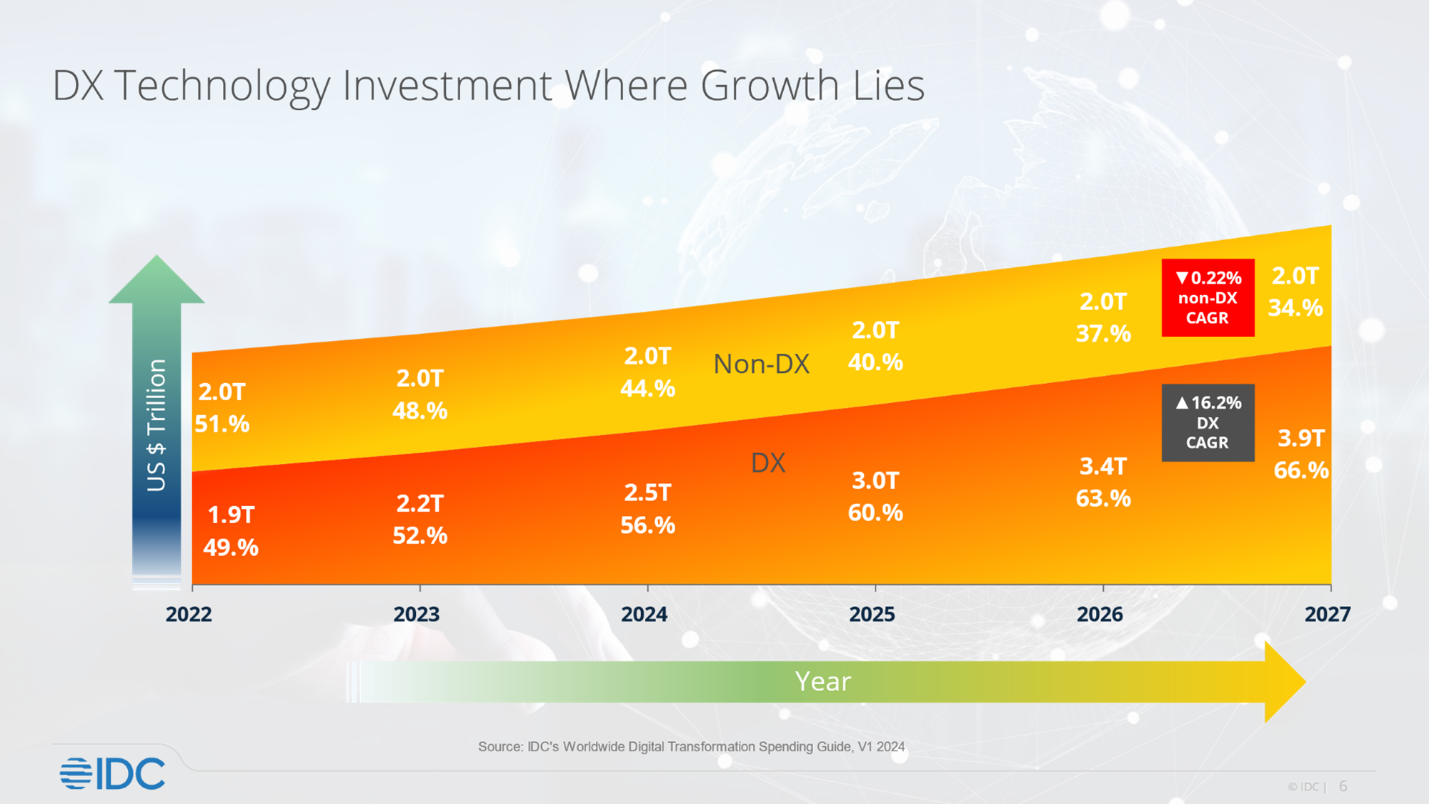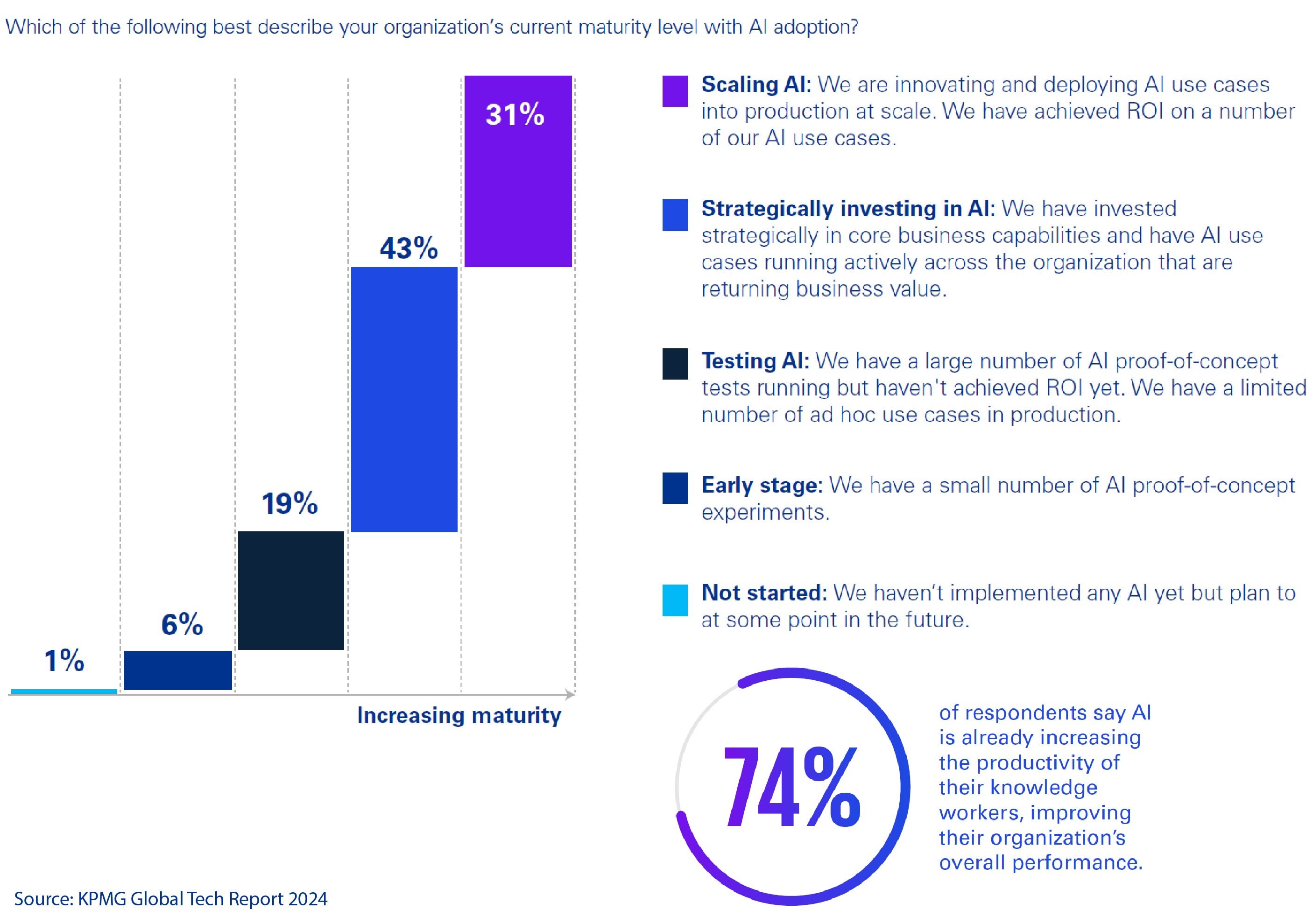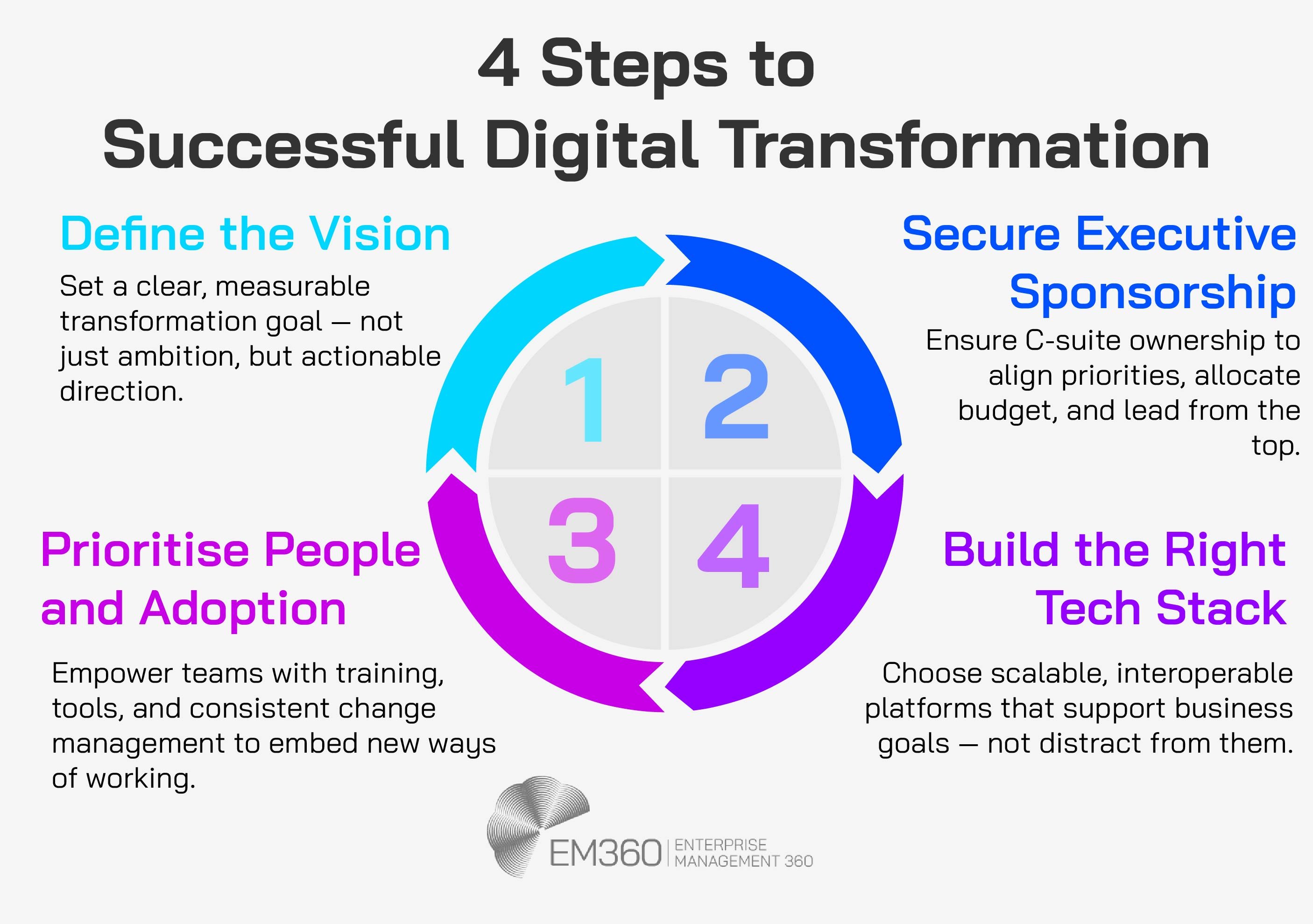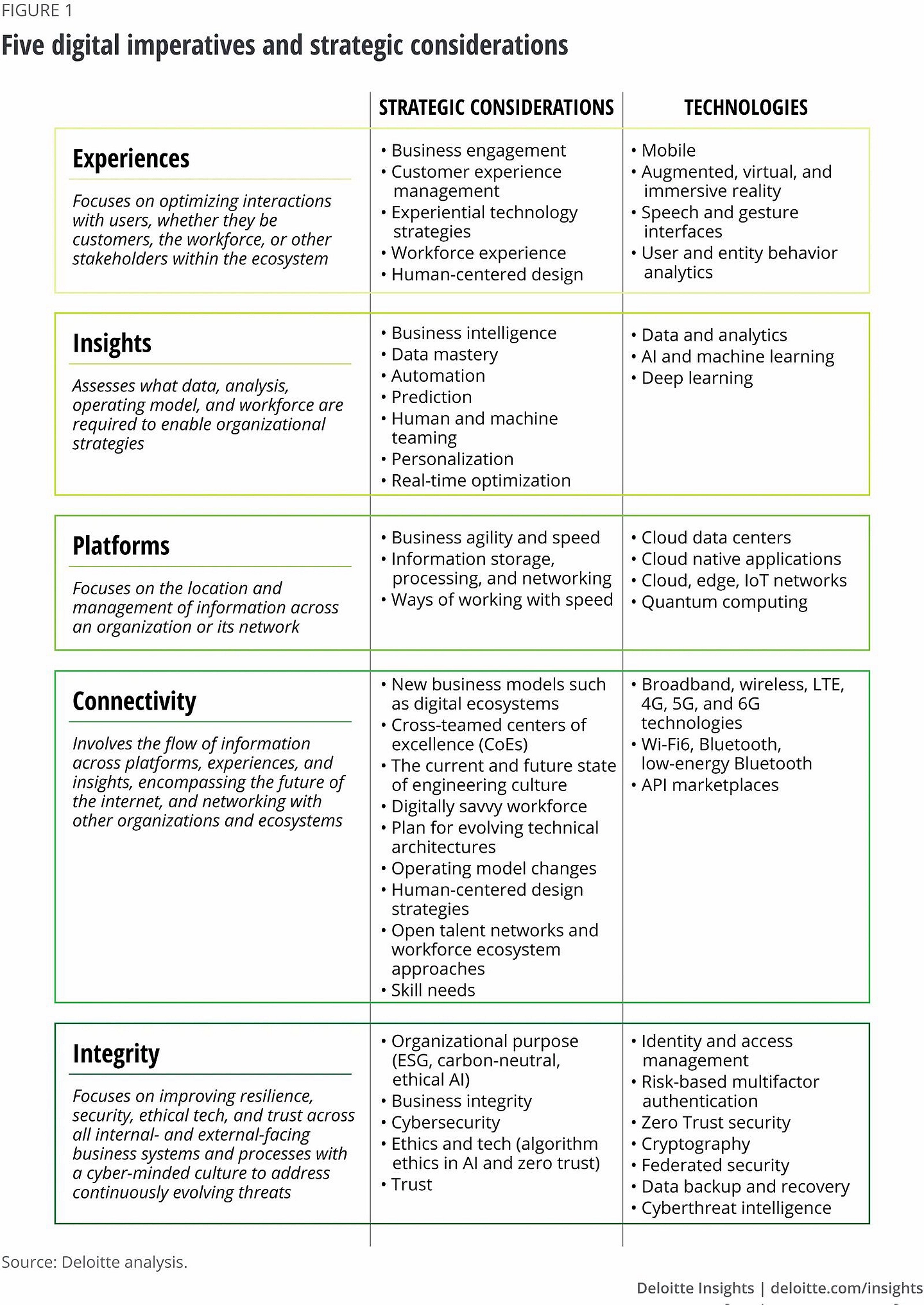
Digital transformation is one of the most ambitious — and misunderstood — undertakings in business today. Organisations are investing heavily to modernise infrastructure, embed new technologies, and rewire the way they deliver value.
But the size of your investment doesn’t guarantee success. And urgency alone won’t carry it forward. Too many initiatives stall and it’s not because leaders lack vision. It’s because they treat transformation as a standalone project, instead of a long-term strategy.
True digital transformation initiatives are both wide-reaching and deeply embedded. It shapes not just the platforms you use but the mindset of the teams using them. Done well, it drives efficiency, insight, and innovation. Done poorly, it drains resources and erodes trust before results can be realised.
So how do you build a transformation strategy that delivers more than disruption?
What Is Digital Transformation?
In the business context, digital transformation refers to the modernisation of operations, customer experiences, and business models through digital capabilities. That might mean moving from paper-based workflows to fully automated systems.
It could also mean building AI into decision-making. Or launching new digital services that meet customer demand faster and better.
In the IT context, it often starts with modernising infrastructure to take advantage of technology advances. These include cloud migration, API integrations, and cybersecurity overhauls.
But it quickly expands to areas like data governance, scalability, and platform agility. Technology isn’t the end goal. It’s the enabler.
Common misconceptions
One of the biggest misconceptions is that digital transformation is a one-time project. Something with a fixed timeline and a neat finish line. In reality, it’s an ongoing capability.
The businesses that succeed aren’t the ones that “completed” digital transformation. They’re the ones that embedded it into how they evolve.
Another common pitfall is thinking transformation equals digitisation or incorporating emerging technologies into your business processes. Digitisation is about converting analogue processes into digital ones. Transformation is about using digital tools to reimagine how the organisation functions — and how it competes.
Digital transformation isn’t about keeping up with trends. It’s about building resilience, unlocking new value, and positioning the business to adapt — again and again.
Why Digital Transformation Matters
The pressure to transform isn’t coming from the technology itself — it’s coming from the pace of change around it. Customer expectations, competitor capabilities, and operational complexity are all accelerating. And businesses that fail to keep up don’t just risk stagnation — they risk irrelevance.
The cost of inaction
The digital transformation journey isn’t without its challenges. But the cost of doing nothing is a whole lot steeper. Legacy systems slow down innovation. Siloed data limits decision-making.
And disconnected processes make it harder to deliver the seamless, responsive experiences today’s customers expect.
Worse still, businesses that delay their digital transformation efforts often find themselves spending more just to stay operational. They spend their time patching outdated infrastructure instead of investing in future-ready capabilities. These organisations are also at a disadvantage when it comes to resilience.
As markets shift and disruptions pop up everywhere, businesses without flexible digital infrastructure are slower to respond and recover. In other words, standing still is a risk strategy. And it’s not a very good one.
Market growth and competitive pressures

At the same time, the market for digital transformation is booming — and not by accident. Global spending is projected to exceed $3.4 trillion in the next year alone, with organisations prioritising cloud adoption, automation, and data-driven insights as key pillars of growth. More than 90 per cent of enterprise leaders say digital transformation is critical to their long-term strategy — yet only a third of initiatives deliver the results they were designed for.
That gap between investment and impact is where the opportunity lies. And it’s where IT leaders must shift from system delivery to digital business enablement. Thereby aligning strategy with scalable digital execution. Because when digital transformation is done well, it doesn’t just support the business — it reshapes it. It creates operational agility, enhances resilience, and unlocks entirely new revenue models.
In today’s economy, transformation isn’t optional. It’s the difference between reacting to change — and leading it.
Benefits of Digital Transformation
From internal operations to customer experience, the right approach to digital transformation unlocks value across every layer of the organisation. Here are five of the most critical benefits:
Increased operational efficiency
Modern digital systems automate manual tasks, reduce duplication, and streamline workflows across departments. This creates faster turnaround times, fewer errors, and more consistent delivery — especially in process-heavy industries like finance, manufacturing, and logistics. Efficiency isn’t just about doing things quicker; it’s about doing them smarter.
Improved customer experience
Digital transformation enables more personalised, responsive, and connected customer journeys. Whether it’s a seamless onboarding process, real-time support, or tailored product recommendations, modern platforms allow businesses to meet users where they are — and evolve with them. In competitive markets, experience is often the differentiator.
Data-driven decision-making
Digitally mature organisations are better positioned to use their data — not just store it. With integrated systems and real-time analytics, leaders can make faster, more informed decisions, uncover hidden opportunities, and respond to risks before they escalate. The ability to act on insight, not instinct, is a game-changer.
Greater agility and scalability
Transformation builds the foundation for adaptability. Cloud infrastructure, API-first systems, and modular tools give businesses the flexibility to scale operations, enter new markets, or pivot strategies without overhauling their entire stack. When conditions shift, agile organisations move — and grow — faster.
Enhanced innovation and growth
With legacy barriers removed and modern capabilities in place, teams are free to explore new ideas. Whether launching new digital products, testing AI use cases, or experimenting with business models, transformation fuels a culture of innovation. It creates space for change — and the systems to support it.
Key Trends and Strategies for 2025
While no two digital transformations look the same, the digital transformation strategies gaining ground in 2025 share some common themes: adaptability, intelligence, and impact at scale. These aren’t passing trends — they’re indicators of where digital transformation is heading and what it now demands.
AI, automation, and cloud scaling
Organisations are moving their business operations beyond experimentation and into deployment — especially when it comes to AI and automation. From generative AI in customer support to intelligent workflows in supply chains, businesses are embedding automation at the core of their operations.
At the same time, cloud maturity is evolving. It’s not just about infrastructure anymore — it’s about platform thinking. Companies are scaling across hybrid and multi-cloud environments to enable faster development, better data flow, and more agile service delivery — often using network-optimised platforms to enhance interconnectivity and reduce latency.

Invisible technology and seamless integration
The most effective technology is often the least visible. In leading organisations, transformation isn’t about bolting on new tools — it’s about building digital capabilities that integrate so seamlessly they feel like an extension of the business itself.
This means unified platforms, connected ecosystems, and user experiences that don’t require tech literacy to navigate. When integration is done right, the technology disappears — and the value becomes the focus.
Responsible AI, governance, and sustainability
As transformation accelerates, so does the pressure to do it responsibly. Ethical AI, strong data governance, and sustainable operations are no longer optional — they’re becoming expected.
From regulatory compliance to public trust, how organisations govern their digital efforts is now a defining factor in long-term success. That includes everything from explainable AI and carbon-aware infrastructure to transparent decision-making processes and cross-functional accountability.
Industry-specific shifts
Different sectors are facing different catalysts. In healthcare, transformation is focused on interoperability and patient data management. In retail, it's about real-time personalisation and omnichannel consistency. In manufacturing, smart factories and IoT integration are driving the next wave of efficiency.
Understanding the nuances of your sector — and the expectations shaping it — is essential for building a strategy that actually lands.
Steps to a Successful Transformation
Successful digital transformation isn’t a checklist — it’s a coordinated shift that demands clarity, leadership, and long-term commitment. These aren’t just best practices — they’re the foundational steps that separate stalled projects from sustained impact.
Building a vision and roadmap
Transformation starts with vision — but vision without a roadmap is just a buzzword. Leaders need to articulate what transformation means for their business, not just in abstract terms, but in measurable outcomes.
That vision should be backed by a phased, prioritised roadmap that connects high-level goals to tactical execution. It needs to balance ambition with practicality, leaving room for iteration without losing direction.
C-suite sponsorship and leadership
Without executive backing, even the most well-planned initiatives lose traction. Digital transformation must be driven from the top — with clear sponsorship, budget ownership, and a leadership team that’s actively involved.
This isn’t about delegation. It’s about creating alignment across business units, setting the pace for change, and showing that transformation is a strategic priority — not a side project.
Choosing the right tech stack
Technology should enable strategy — not dictate it. The right stack is one that aligns with business goals, scales with demand, and integrates easily across your environment. That means moving away from isolated point solutions and toward interoperable, future-ready platforms.
Crucially, it also means evaluating how technology will be used — by whom, in what context, and with what level of training or support.
Change management and internal adoption
Transformation doesn’t succeed unless people come with it. That means equipping teams with the tools, training, and support they need to embrace new ways of working — and creating space for feedback and iteration.
Change management isn’t a one-time initiative. It’s an ongoing process that requires communication, clarity, and a culture that sees change as an opportunity — not a threat.

Challenges and Pitfalls to Avoid
For all the value digital transformation can unlock, it also comes with risk. Not just financial risk — but strategic, cultural, and operational risk. Many of the most common pitfalls don’t stem from poor technology choices. Instead it's organisational missteps that undermine even the best-laid plans.
Lack of strategy or leadership
One of the fastest ways to derail transformation is to dive in without a clear direction — or without the leadership to see it through. When digital efforts are fragmented across departments, driven by short-term goals, or treated as purely technical projects, they struggle to gain traction.
Without strong leadership and a unified vision, transformation becomes reactive instead of strategic — and momentum is lost before value is realised.
Resistance to change and poor communication
Even the most promising initiative will stall if the people behind it don’t believe in it. Change fatigue, unclear messaging, and lack of involvement from frontline teams can quickly turn enthusiasm into resistance.
Successful transformation requires more than stakeholder buy-in — it demands cultural alignment and executive-level ownership, particularly from CIOs balancing short-term delivery with long-term vision. That means creating consistent, transparent communication and giving people a reason to engage with the change — not just comply with it.
Fragmented tech or data silos
When systems don’t talk to each other, neither do teams. Fragmented tech stacks and siloed data are two of the most common — and costly — barriers to transformation. They slow down collaboration, complicate reporting, and make it harder to deliver a unified customer experience.
True transformation requires integration. Not just at the infrastructure level, but across data, processes, and platforms. Without it, you’re not transforming — you’re just layering complexity.
Best Practices and Frameworks
There’s no one-size-fits-all model for digital transformation — but some frameworks do a better job than others at balancing structure with flexibility. These are the models leading organisations are using in 2025 to align teams, build capability, and drive results that last.
BCG digital transformation layers
BCG’s approach breaks transformation into three layers, each serving a different purpose:
- Quick wins deliver visible value early — often through automation, process fixes, or new digital touchpoints.
- Capability building focuses on talent, tools, and infrastructure needed for long-term resilience.
- Structural transformation rethinks the core business model, often through platform redesigns, new service lines, or ecosystem partnerships.
This layered strategy helps leaders manage short-term expectations while still investing in long-term change — a crucial balance when stakeholder pressure is high.
McKinsey 7S model
Rather than focusing solely on tech or process, the 7S framework looks at the organisation as an interconnected system. The seven elements — strategy, structure, systems, shared values, style, staff, and skills — act as a diagnostic tool for alignment.
If a transformation initiative fails to land, this model helps pinpoint why. Maybe the strategy is solid, but leadership styles haven't evolved. Maybe new systems are in place, but team skills haven’t caught up. It’s a powerful framework for CEOs who need to understand both the hard and soft levers of change.
Deloitte digital transformation framework
Deloitte’s digital transformation approach centres around five interconnected elements that ensure transformation is both strategic and sustainable:
- Experiences — optimising how users engage with your business, whether they’re customers, employees, or partners.
- Insights — turning data into strategic advantage through the right operating models, analytics, and workforce capabilities.
- Platforms — focusing on how and where information is stored, accessed, and managed across the organisation.
- Connectivity — enabling seamless data flow across platforms, experiences, and ecosystems to support agility and innovation.
- Integrity — embedding trust, cybersecurity, and ethical tech practices into every layer of the transformation effort.
This framework is particularly effective for organisations navigating complex stakeholder environments. It offers a structured way to evolve both front-end and back-end systems without losing sight of security, interoperability, or user experience.

Gartner’s five-phase life cycle
Gartner structures transformation into a life cycle: ambition, design, deliver, scale, and harvest. Each phase comes with its own risks, metrics, and success factors.
- Ambition sets direction — the “why” behind transformation.
- Design outlines how transformation will unfold, including architecture, roles, and timelines.
- Deliver activates change through pilots and early deployment.
- Scale expands successful models across teams or geographies.
- Harvest focuses on optimisation and ROI realisation.
This phased model is ideal for enterprises looking for structured governance without sacrificing agility.
Lean digital transformation
Rooted in Lean principles, this model focuses on eliminating waste and maximising customer value. It’s built on tight feedback loops, small-batch experimentation, and measurable outcomes — not vanity metrics.
Lean transformation works especially well in process-heavy industries where marginal gains translate into major cost savings. It also supports a strong culture of continuous improvement, which helps keep momentum going long after go-live.
TOGAF (The Open Group Architecture Framework)
TOGAF is one of the most widely used frameworks for enterprise architecture — and remains a go-to for CIOs managing complex transformation portfolios. It breaks architecture into four domains: business, data, application, and technology, with guidance for planning, execution, and governance.
While TOGAF is often seen as technical, its modular structure makes it a strategic asset for aligning IT with business outcomes. It’s best suited to large organisations with multiple systems, departments, or compliance obligations.
TOGAF is best suited to large organisations with multiple departments, systems and compliance obligations — especially when integration is led by a capable system integrator working across business and IT functions.
Agile4Enterprise (A4E)
Agile4Enterprise is a lightweight, open-source framework that applies Agile principles to enterprise environments without the rigidity of some scaled Agile methods. It’s modular, transparent, and built for iteration — making it a strong fit for mid-sized organisations looking for transformation structure without bureaucracy.
It supports just enough process to stay on track while giving teams freedom to adapt as they go. That makes it ideal for businesses that want agility at scale but don’t want to adopt heavyweight models like SAFe or LeSS.
Industry Examples and Case Studies
These are real-world examples of organisations that have translated strategy into tangible transformation. They’re not just pilot projects, but initiatives that deliver measurable impact.
JPMorgan Chase: GenAI at scale
JPMorgan factored generative AI into its core operations by rolling out their LLM Suite, now used by around two hundred thousand employees. The bank didn’t treat this as a side project. Instead it became a strategic value lever, boosting client-facing roles, streamlining legal workflows, and enhancing advisory services.
Key takeaways for leadership:
- Enterprise-first deployment — use cases designed with scale in mind.
- Change management at high scale — extensive training, oversight, and trust-building.
- Strong governance — controls to manage risk, prevent hallucinations, and ensure compliance.
This shows how an institution can shift from cautious experimentation to confident adoption. And pave the way for productivity gains and strategic differentiation.
Walmart: Digital twins for smarter operations
Walmart has created digital twins of over seventeen hundred stores using AI models and 3D simulations. These virtual replicas help teams test store layouts, optimise supply chains, and improve in-store experiences. ANd they do it all before spending a dime on the shop floor.
This initiative captures:
- Invisible integration — tech that feels invisible but enhances decision-making.
- Operational agility — rapid iteration in a simulated environment.
- Measured ROI — decisions made offline to minimise cost and disruption.
It’s a strong example of how digital transformation can directly support customer experience and operational excellence across a large, complex retail ecosystem.
Austin PBS: Resilient tech for public broadcasting
Amid pandemic delays, flood damage, and supply chain issues, Austin PBS launched a modern media centre. Complete with integrated studios, postproduction systems, and community training spaces.
This case stands out because:
- Strong partnership excellence — system integrators providing both tech and training.
- Resilience by design — infrastructure designed to cope with real-world shocks.
- Community impact built-in — the project supports both broadcasting and education.
Austin PBS proves that transformation isn’t reserved for global enterprises. Even legacy institutions can reinvent themselves with vision, collaboration, and smart execution.
These examples reflect several shared success factors:
- Strategic intent before tech: From AI at JPMorgan to virtual twin systems at Walmart, tools were deployed only after clear business goals were set.
- Governed execution: Successful transformations had strong frameworks for deployment, people, and technical oversight.
- Agile adaptation: Each initiative used iterative development and built-in flexibility — not big- launches.
These aren’t just interesting stories — they offer clear playbooks. Whether you’re in banking, retail, or public services, real, measurable transformation is possible. Especially if you have support from experienced digital transformation partners who understand the complexity of enterprise change
Final Thoughts: Build for Flexibility, Lead with Intent
The organisations that thrive in the next phase of digital transformation won’t be the ones with the most tools. They’ll be the ones with the clearest intent.
Strategy will matter more than speed. Culture will matter more than code. People, not just infrastructure, will build resilience.
Expect to see a shift toward skills-first hiring, with less emphasis on formal qualifications and more on adaptability, learning agility, and digital literacy. Platform ecosystems — especially those powered by mobile and edge technologies — will continue to rise. Which will help businesses plug in new capabilities without rebuilding from scratch.
Platform ecosystems will continue to rise, enabling businesses to plug in new capabilities without rebuilding from scratch. And long-term resilience in both systems and strategy will become the true measure of transformation success.
Now’s the time to audit your approach. Is your strategy still fit for purpose? Are your teams equipped to evolve with the technology you’re adopting? Are you building for what’s next — or just reacting to what’s now?
Digital transformation doesn’t end with implementation. It continues with every decision, every iteration, and every step forward.
To stay ahead of the conversation — and see how other leaders are navigating the next wave of transformation — explore the latest insights, interviews, and reports at EM360.














Comments ( 0 )